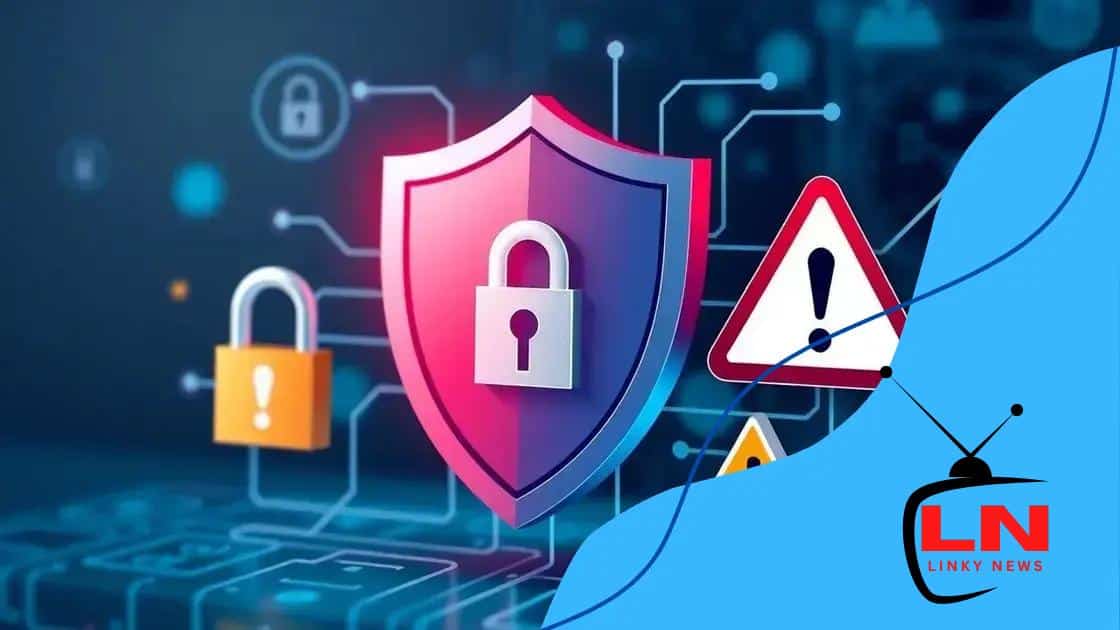Digital identity in financial services: what you need to know

Securing your digital identity involves using strong passwords, enabling two-factor authentication, and staying aware of phishing threats to protect personal and financial information online.
In today’s world, digital identity in financial services is more important than ever. With the rise of online banking and transactions, understanding how digital identities operate helps us stay secure and informed. But how does this affect your daily interactions with financial institutions?
Understanding digital identity and its importance
Understanding digital identity is essential in today’s financial landscape. It serves as the foundation for secure transactions, enabling individuals and institutions to interact safely and efficiently online.
Digital identity encompasses various aspects, such as personal information, authentication methods, and digital footprints. It is not just about having a user account; it involves how you are recognized by organizations across the digital space.
Components of Digital Identity
Several key components make up a digital identity:
- Personal Information: This includes your name, address, and contact details.
- Authentication Methods: Passwords, biometric data, and two-factor authentication secure your accounts.
- Digital Footprint: Your browsing history, social media profiles, and online interactions contribute to your profile.
These elements work together to create a comprehensive view of who you are in the digital realm. The importance of protecting your digital identity cannot be overstated. Since many financial services operate online, any breach can lead to identity theft and significant financial loss.
Why Is Digital Identity Important?
A strong digital identity fosters trust between users and financial institutions. Customers feel secure knowing their information is protected, leading to increased confidence in digital transactions.
Moreover, a well-managed digital identity ensures compliance with regulations and safeguards against fraud. Financial services must adopt robust systems to verify identities, avoid scams, and protect their customers.
In conclusion, with the growing reliance on digital services, understanding and protecting your digital identity is crucial. It empowers you to engage in safe and efficient online interactions, especially within the financial sector.
The role of digital identity in online banking
The role of digital identity in online banking is crucial for ensuring security and trust. Every transaction relies on the accurate verification of users’ identities, which is essential for preventing fraud and protecting personal information.
When you log into your online banking account, multiple components work together to confirm your identity. These include your username, password, and, often, additional verification methods like a code sent to your smartphone. Digital identity allows banks to authenticate users swiftly while keeping potential fraudsters at bay.
Key Functions of Digital Identity in Banking
Digital identity plays several important roles within the banking sector:
- Authentication: Ensures that only authorized individuals can access their accounts.
- Fraud Prevention: Detects suspicious behavior by verifying user activity against their historical patterns.
- Compliance: Helps banks adhere to legal requirements by keeping customer information secure.
As online banking continues to evolve, the reliance on digital identity deepens. Financial institutions are investing in advanced technologies, such as biometrics and machine learning, to enhance security measures further.
Challenges of Digital Identity in Online Banking
Despite its benefits, managing digital identity poses challenges. For example, customers may forget passwords, risking their access. Moreover, phishing attacks target users, attempting to steal their authentication details.
Financial institutions must be proactive in educating customers about safeguards. Encouraging the use of strong passwords and two-factor authentication can significantly improve security. By taking these steps, banks not only protect their clients but also enhance their confidence in using online services.
Risks and challenges of digital identity management

The management of digital identity comes with numerous risks and challenges that both individuals and organizations must recognize. Understanding these issues is vital for anyone engaging in online services.
One major risk is data breaches. When personal information is not adequately protected, cybercriminals can exploit it, leading to identity theft and fraud. Every year, millions are affected by data leaks, causing financial and emotional distress.
Key Challenges in Digital Identity Management
Managing digital identity presents several challenges:
- Complex Authentication Processes: Balancing security and user convenience can be difficult. Overly complicated processes may frustrate users.
- Privacy Concerns: Users often worry about how their personal data is used. Transparency and trust are crucial for effective management.
- Regulatory Compliance: Adhering to laws and regulations can be strict and complicated, particularly for businesses.
Moreover, the usage of weak passwords remains a persistent challenge. Many people still rely on simple passwords that are easy to guess. Encouraging stronger password practices and utilizing password managers can help mitigate this issue.
The Impact of Phishing Attacks
Phishing attacks pose another significant threat. These attempts trick users into revealing their credentials or installing malware. Education around recognizing phishing attempts is essential for safeguarding digital identity. Users must be aware of the common signs, such as suspicious emails or links.
In conclusion, addressing the risks and challenges of digital identity management requires vigilance and proactive strategies. While threats persist, improving user awareness and implementing advanced security measures can significantly reduce risks in an ever-evolving digital environment.
Trends shaping digital identity in finance
Trends in digital identity are continuously evolving, particularly in the finance sector. As technology advances, so do the ways we manage and secure our digital identity.
One notable trend is the increased use of biometric authentication methods. Fingerprints, facial recognition, and iris scans are becoming more common for securing online transactions. This technology enhances security while providing a seamless user experience.
Decentralized Identity Solutions
Another trend reshaping digital identity management is the rise of decentralized identity solutions. Traditional identity management typically relies on centralized databases, making them vulnerable to breaches. Decentralized systems give users more control over their personal information.
- Self-sovereign Identity: Users can manage their own identities without relying on intermediaries.
- Blockchain Technology: This technology helps create tamper-proof records, enhancing security.
- Privacy by Design: Solutions are developed with privacy considerations from the beginning.
As these solutions gain traction, financial institutions are exploring how to integrate them into existing platforms. This shift aims to provide users with more privacy and improved security.
AI and Machine Learning in Digital Identity
Artificial intelligence (AI) and machine learning are also making significant impacts on digital identity management. These technologies can analyze vast amounts of data to identify patterns or anomalies. By detecting suspicious activity in real-time, banks can prevent fraud before it happens.
Additionally, AI can enhance user verification processes, making them more efficient and accurate. Techniques like behavioral biometrics analyze how users interact with devices, providing another layer of security.
These trends highlight the significant shifts happening in the management of digital identities in finance. Keeping up with these advancements not only helps protect users but also fosters greater trust in online financial services and applications.
Best practices for securing digital identities
Securing your digital identity is essential in today’s online world. As technology evolves, adopting best practices becomes critical for ensuring personal and financial safety.
One effective practice is to use strong, unique passwords for each online account. Avoid using easily guessable information, like birthdays or common words. Password managers can help generate and store complex passwords securely.
Enable Two-Factor Authentication
Another vital step is enabling two-factor authentication (2FA) wherever possible. This adds an extra layer of security by requiring a second form of identification, such as a code sent to your phone. Even if your password is compromised, 2FA can prevent unauthorized access.
- Use a Password Manager: Store and generate unique passwords safely.
- Regularly Update Passwords: Change passwords regularly to reduce risks.
- Be Cautious with Public Wi-Fi: Avoid accessing sensitive information over unsecured networks.
Additionally, regularly monitoring bank statements and credit reports can help detect unauthorized activity early. If something seems off, report it immediately.
Educate Yourself about Phishing
Education is a powerful tool in protecting your digital identity. Learn to recognize phishing attempts, which often come in the form of emails or messages that mimic legitimate sources. These can trick you into providing personal information.
Look for signs of phishing, such as generic greetings, poor grammar, or suspicious links. Being vigilant can save you from falling victim to these attacks. Remember, legitimate organizations will never ask for sensitive information via email.
By following these best practices, you can significantly enhance the security of your digital identity. Protecting yourself in this digital age requires a proactive approach and ongoing awareness.
In summary, protecting your digital identity is essential in our increasingly online world. By following best practices such as using strong passwords, enabling two-factor authentication, and educating yourself about potential threats, you can significantly reduce risks. Being aware of common challenges and trends also allows for better management of your online presence. With continuous vigilance and the right tools, you can enjoy safer online experiences in finance and beyond.
FAQ – Frequently Asked Questions about Securing Digital Identities
What is a strong password?
A strong password is at least 12 characters long and includes a mix of letters, numbers, and symbols.
How does two-factor authentication work?
Two-factor authentication adds an extra layer of security by requiring a second form of verification, like a code sent to your phone.
Why is it important to monitor my accounts?
Monitoring your accounts helps you spot unauthorized transactions quickly, allowing you to act before further damage is done.
What should I do if I receive a phishing email?
Do not click any links or provide personal information; instead, report the email to your email provider and delete it.





